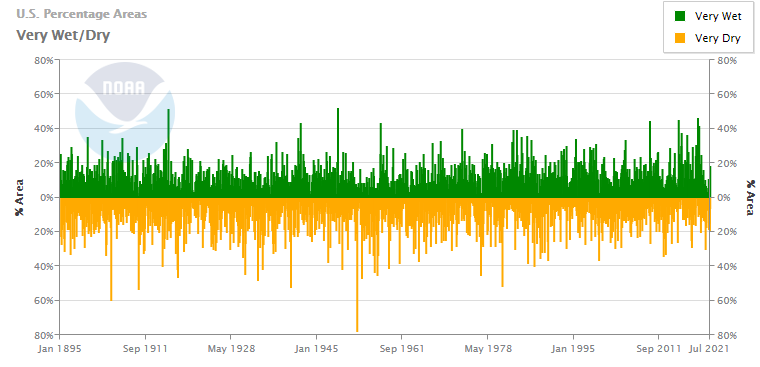Under its “Extreme Weather and Climate Updates,” section online, the New York Times, suggests climate change is causing drought conditions in the United States to worsen. This is false.
Data show no significant increase of drought in the United States during the recent period of modest warming. In fact, data indicate, if anything, most of the United States has experienced more rainfall during the past 150 years, becoming less prone to extended drought.
“Nearly half of the land mass of the contiguous United States — 47 percent — is experiencing drought conditions, according to the latest report from the U.S. Drought Monitor, and it’s getting worse in the Northern Plains and everywhere west of the Rocky Mountains,” wrote the New York Times on August 25. “Droughts are a normal part of life, especially in the American West, where they have occurred regularly throughout the centuries. But scientists say that climate change, in the form of warming temperatures and shifts in precipitation, is making the situation worse.”
Historically, it is common for more than 40 percent of the United States to be experiencing drought at any period of time. What is uncommon is for less than 40 percent of the country to be experiencing drought, yet, as reported in Climate at a Glance: Drought, that just what the National Oceanic and Atmospheric Administration (NOAA) data show occurred recently.
Data show in 2017 and 2019, the United States registered its smallest percentage of land area experiencing drought in recorded history. Weather patterns began to shift in 2020, bringing drought to a large portion of the United States. Until then, however, NOAA reported United States had been experiencing its longest period in recorded history without at least 40 percent of the country experiencing “very dry” conditions.
As NOAA data presented in Figure 1 below show, drought peaks around 1978, 1954, 1930, and 1900 were much larger than what the U.S. experienced in the 21st century and the late 20th century.

Rather than drought increasing, the United Nation’s Intergovernmental Panel on Climate Change (IPCC) reports, with “high confidence” that precipitation has increased over mid-latitude land areas of the Northern Hemisphere, including the United States, during the past 70 years. The IPCC has “low confidence” about any negative trends globally.
On page 12 of the Summary for Policymakers of the IPCC’s recently released 6th Assessment Report, the organization divides the world into 47 separate regions of study when analyzing drought trends. The report suggests drought may have increased during the period of modest warming in 12 of those 47 regions. And in only two of those regions does the IPCC have even “medium confidence,” for any human role in the observed increase: the Western United States and the Mediterranean. For the remaining regions experiencing a possible increase in droughts, the IPCC has low confidence human activities have had any discernable impact. Medium confidence for two small areas is far from scientists being confident humans are making drought conditions worse, as the New York Times implies.
As an earlier Climate Realism post discussed, the Western United States is not experiencing a mega-drought as some reports claim. Indeed, current conditions are not outside the historic records of drought for the region.
Drought is a weather phenomenon, only becoming an indicator of climate change if it persists for 30 years. The classical period is 30 years, as defined by the World Meteorological Organization (WMO). The NYT is confusing weather and climate. The National Oceanic and Atmospheric Administration (NOAA) defines it well:
“Weather reflects short-term conditions of the atmosphere while climate is the average daily weather for an extended period of time at a certain location. … Weather can change from minute-to-minute, hour-to-hour, day-to-day, and season-to-season.”
No region of the United States is experiencing an extended period of drought, indicating climate change. The U.S. Environmental Protection Agency (EPA) reintroduced its Climate Change Indicator series in mid-May. The agency’s post, titled “Climate Change Indicators: Drought,” reported no trend towards greater numbers of droughts or droughts of greater severity, see Figure 2 below.
“Average drought conditions across the nation have varied over time,” writes EPA. “The 1930s and 1950s saw the most widespread droughts, while the last 50 years have generally been wetter than average. Over the entire period … the overall trend has been toward wetter conditions,” wrote EPA.

Indeed, rains, aka “weather,” during the past week have reduced the area of the United States experiencing drought, making the data cited by the New York Times obsolete in less than 24 hours. Data from the U.S. Drought Monitor show the area of the United States currently drought free has increased. Only one of categories of drought listed by the Drought Monitor, Moderate Drought, has shown a modest increase during the past week. The area experiencing Moderate Drought increased because widespread rainfall resulted in areas experiencing Exceptional Drought, Extreme Drought, and Severe Drought, declining. Millions of acres formerly listed as experiencing the most serious categories of drought, have moved in a positive direction, being relisted in the Moderate Drought category in just one week.
Contrary to science, the New York Times seems intent on turning any temporary extreme weather event, in this case a severe regional drought, into proof of climate change. What the New York Times can’t change are the facts, the primary one being the current drought is a weather condition, which even the IPCC can’t link to climate change. As it has for many areas of the United States in the past week, drought conditions, like the weather, can change with the next rainfall pattern, and they undoubtedly will, with some areas experiencing wetter conditions, some drier. Climate change has nothing to do with it.



















well tell hover dan its full of water the reason there is climate change is because weve cut down and killed 50% of the forest cover lets say a stand of very large trees as 300 / acre absorbs some 500,000 tons of carbon / year problem is theres only 10% left. if not less these trees where needed to carbon sink co2 from forest fires. that only the small part of the problem these deep rooted trees maintianed 30 to 50 feet of ground water the actual trees contain at least 50% moisture some 2000 gallons of water respired each day /tree is what actually drives the water cycle. loggers cant help themselfs 500,000 cubic feet of wood equels 100,000 dollars /acre in net profit now theyve convinced you that an seeedling is the same as 4000 cubic foot tree at 80years old this tree is worth 3000 dollars. but its the same as a 7dollar seedling. the new mantra is thinning prevents forest fires but the oppisite has been shown that large stand create there own climate and soil moisture reducing fire siverity and stand fire kill to less than five percent. where as thinned forests burn over 90% of the stand. keep listening to the experts you need to live in the forest to understand the resilance of a mature stand of trees with a temperature difference of 50 degrees f.
The NYT’s has been faking the news since 1932 and covered up for Stalin,Hitler,Castro and the Vietcong and a re spreading this 1619 lie as w ell not woth the per its printed on to bother reading this leftists rag